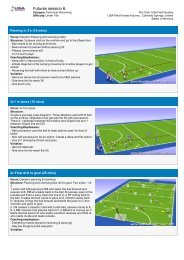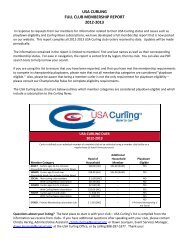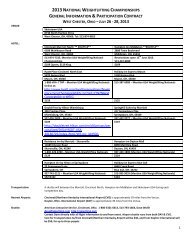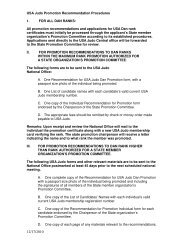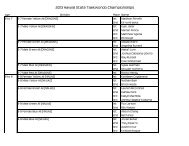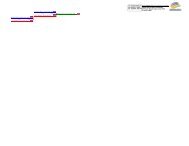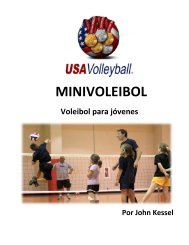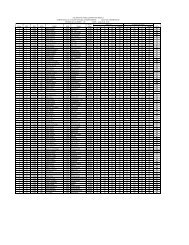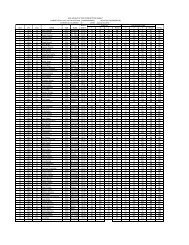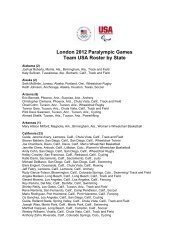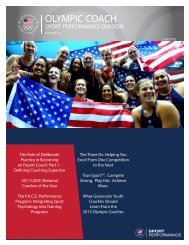Strength and Power for the Elite Swimmer 2012 - United States ...
Strength and Power for the Elite Swimmer 2012 - United States ...
Strength and Power for the Elite Swimmer 2012 - United States ...
You also want an ePaper? Increase the reach of your titles
YUMPU automatically turns print PDFs into web optimized ePapers that Google loves.
Olympic Coach Magazine<br />
26<br />
Volume 23, Issue 2<br />
powerful <strong>for</strong>ce than if only one person would “tug” at a time. In addition, imagine that <strong>the</strong>re were some<br />
lazy people on <strong>the</strong> team that usually only chose to “tug” if <strong>the</strong> team were losing; <strong>the</strong>se teammates would<br />
be conditioned to tug in unison with <strong>the</strong> team from <strong>the</strong> very beginning of <strong>the</strong> game leading to an overall<br />
much more powerful “tug.” The adaptation to <strong>the</strong> physical properties of <strong>the</strong> muscle fibers would be that<br />
<strong>the</strong> fibers <strong>the</strong>mselves would become stronger <strong>and</strong> <strong>the</strong> enzymes within <strong>the</strong> fiber would become more effective<br />
at initiating biochemical reactions.<br />
This use of strength training - <strong>and</strong> more specifically power training - can improve <strong>the</strong> rate of <strong>for</strong>ce development<br />
of <strong>the</strong> muscle, muscle groups, <strong>and</strong> overall athlete, which has been suggested to be a greater<br />
determinant of athletic success than just power alone (Newton <strong>and</strong> Kraemer, 1994).<br />
It is important to realize that within <strong>the</strong> human body movements are primarily a result of torques <strong>and</strong> <strong>the</strong><br />
magnitude of <strong>the</strong> torques will decrease with velocity (Heusner, 1980). There<strong>for</strong>e, at <strong>the</strong> elite level an<br />
athlete should not only train to be strong <strong>and</strong> generate large <strong>for</strong>ces, but train to develop a larger torque<br />
at high sport-specific velocities. A simple example would be to try <strong>and</strong> increase <strong>the</strong> speed of a moving<br />
object in <strong>the</strong> same direction. If <strong>the</strong> object is moving at a slow speed it will be easy to apply a <strong>for</strong>ce to <strong>the</strong><br />
object <strong>and</strong> accelerate it. But if <strong>the</strong> object is moving too fast, it may be too difficult to apply an impulse to<br />
<strong>the</strong> object to accelerate it. This is a simple example that can easily be applied to swimming. If an athlete<br />
has an improved rate of <strong>for</strong>ce development <strong>the</strong>n <strong>the</strong> athlete will be able to “catch” <strong>the</strong> water, begin<br />
generating torque <strong>and</strong> start applying <strong>for</strong>ce in a shorter amount of time, leading to greater acceleration of<br />
<strong>the</strong>ir body through <strong>the</strong> water. When an athlete does not possess a high rate of <strong>for</strong>ce development, an<br />
athlete will not be able to “catch” <strong>and</strong> “pull” water more quickly than <strong>the</strong>ir opponent.<br />
Ano<strong>the</strong>r important concept related to strength <strong>and</strong> power training of elite athletes is <strong>the</strong> focus on training<br />
movements, not muscles. Ra<strong>the</strong>r than focusing on <strong>the</strong> development of each muscle individually, a<br />
program that improves per<strong>for</strong>mance focuses on <strong>the</strong> training of movements, primarily pushing <strong>and</strong> pulling.<br />
Training <strong>the</strong> muscles of <strong>the</strong> extremities is secondary to training <strong>the</strong> muscles near <strong>the</strong> torso as <strong>the</strong><br />
muscles of <strong>the</strong> torso tend to have a greater ability to generate <strong>for</strong>ces that would help enhance athletic<br />
per<strong>for</strong>mance. An example of training a movement would be <strong>the</strong> use of an Olympic weightlifting move-



